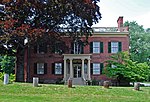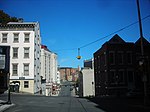Stephen and Harriet Myers Residence

The Stephen and Harriet Myers Residence is located on Livingston Avenue in Albany, New York, United States. It is a Greek Revival townhouse built in the mid-19th century. In 2004, it was listed on the National Register of Historic Places. It is also listed on the New York State Underground Railroad Heritage Trail and is a site on the National Park Service's National Network to Freedom. Stephen Myers, himself freed from slavery in his youth, served for a time as chairman of the Vigilance Committee of Albany, which met in the house built and owned by an African American boat captain who was his brother-in-law. Stephen and his wife Harriet actively assisted others escaping from slavery for nearly 30 years; he also edited some abolitionist newspapers and spoke with Frederick Douglass at anti-slavery events. The house was later saved from demolition during urban renewal in the 1970s. It is being restored by the Underground Railroad Education Center, a community-based historical society, with public and private funds.
Excerpt from the Wikipedia article Stephen and Harriet Myers Residence (License: CC BY-SA 3.0, Authors, Images).Stephen and Harriet Myers Residence
Livingston Avenue, City of Albany
Geographical coordinates (GPS) Address Nearby Places Show on map
Geographical coordinates (GPS)
| Latitude | Longitude |
|---|---|
| N 42.660833333333 ° | E -73.754166666667 ° |
Address
Livingston Avenue 186
12210 City of Albany
New York, United States
Open on Google Maps









